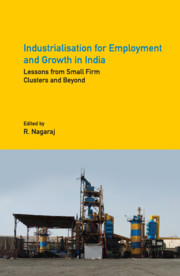Book contents
- Frontmatter
- Contents
- List of Tables
- List of Figures and Maps
- Preface and Acknowledgements
- 1 Introduction
- 2 Garment Cluster in Kolkata: The Untold Story of Expansion Relying on Low-end Domestic Demand
- 3 Constraints to Upgrading and Employment Expansion in the Tiruppur Knitwear Cluster
- 4 Determinants of Employment in the Indian Automobile Industry
- 5 Upgrading Technology and Space as Collective Strategy: Creation of Jobs and Market Potential in Gujarat’s Ceramic Clusters
- 6 Sports Equipment Manufacturing in India: A Firm-level Inquiry into Growth and Employment Dynamism
- 7 Aligarh Lock Cluster: Unravelling the Major Impediments
- 8 Continued Misery or a Change in Fortune? The Case of the Howrah Foundry Industry
- 9 Redevelop and Perish, or Survive and Grow? The Case for Supporting Informal Leather Enterprises in Dharavi, Mumbai
- 10 Growth Performance, Competitiveness and Employment in MSMEs: A Case Study of the Rajkot Engineering Cluster
- 11 Manufacturing and Automation
- About the Contributors
- Index
3 - Constraints to Upgrading and Employment Expansion in the Tiruppur Knitwear Cluster
Published online by Cambridge University Press: 31 July 2021
- Frontmatter
- Contents
- List of Tables
- List of Figures and Maps
- Preface and Acknowledgements
- 1 Introduction
- 2 Garment Cluster in Kolkata: The Untold Story of Expansion Relying on Low-end Domestic Demand
- 3 Constraints to Upgrading and Employment Expansion in the Tiruppur Knitwear Cluster
- 4 Determinants of Employment in the Indian Automobile Industry
- 5 Upgrading Technology and Space as Collective Strategy: Creation of Jobs and Market Potential in Gujarat’s Ceramic Clusters
- 6 Sports Equipment Manufacturing in India: A Firm-level Inquiry into Growth and Employment Dynamism
- 7 Aligarh Lock Cluster: Unravelling the Major Impediments
- 8 Continued Misery or a Change in Fortune? The Case of the Howrah Foundry Industry
- 9 Redevelop and Perish, or Survive and Grow? The Case for Supporting Informal Leather Enterprises in Dharavi, Mumbai
- 10 Growth Performance, Competitiveness and Employment in MSMEs: A Case Study of the Rajkot Engineering Cluster
- 11 Manufacturing and Automation
- About the Contributors
- Index
Summary
Introduction
When the quota system for the global garment trade came to an end with the expiry of the multi-fibre arrangement (MFA) in 2005, questions arose on how the removal of quantitative restrictions on exports will impact different countries (Joshi 2002; Vijayabaskar 2002). China and, to a lesser extent, India were expected to be the biggest gainers in the new global trading regime given their better production capabilities. After more than a decade, while China has indeed gained considerably with a global market share of 37 per cent in 2015, India's share has only marginally increased from around 3.5 per cent to 4.2 per cent in 2015 (Ministry of Textiles 2018b). As garment manufacturing is the most labour-intensive segment within textiles, this stagnation in market has implications for expanding manufacturing employment in India. There are two dimensions of such employment generation. An increase in global market shares for garments through improved competitiveness can translate into expansion of employment opportunities. Second, literature suggests that it is important for producers to upgrade, that is, to move into more value-adding segments rather than to compete merely on the basis of low wage costs to ensure better returns to production (Gereffi 1999). Appropriation of more value also enables producers to improve the quality of employment, which is particularly important in the context of countries such as India characterised by a substantial presence of the ‘working poor’. This upgrading, particularly functional upgrading into downstream and upstream segments and diversification into related industries (Neffke, Henning and Boschma 2011), also generates additional employment linkages.
Despite stagnation in global market shares, expansion in output has been accompanied by shifts in product composition of garment production in India. Within apparels, there has been an increase in the share of knitted garments from about 17 per cent to 21 per cent during 2006–16 (Indian Institute of Foreign Trade 2018). Tiruppur, a cluster in southern India comprised of a dense network of over 5,000 small and medium firms specialising in different stages of garment production, is the biggest centre of the country's cotton knitwear exports. Firms in the cluster cater to several leading retail chains and supermarkets, particularly in Europe and USA.
- Type
- Chapter
- Information
- Industrialisation for Employment and Growth in IndiaLessons from Small Firm Clusters and Beyond, pp. 49 - 71Publisher: Cambridge University PressPrint publication year: 2021



